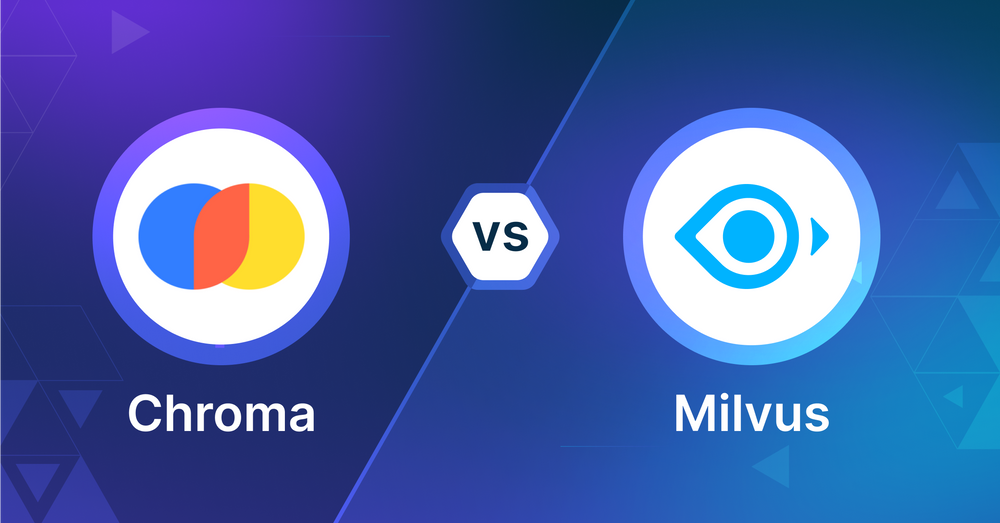Choosing a Vector Database: Milvus vs. Chroma DB

This Milvus vs. Chroma DB comparison was last updated on January 21, 2025. To provide you with the latest findings, this blog will be regularly updated with the latest information.
The rise of large language models (LLMs) like ChatGPT has spurred a demand for vector databases serving as the long-term memory for these models. This demand has led to the development of various vector search systems, spanning traditional databases with integrated vector search plugins, lightweight vector databases, and purpose-built vector databases. Different vector databases utilize various distance metrics to assess relationships and similarities between data points, highlighting the importance of choosing the right database for effective vector similarity search.
Chroma vector database is a noteworthy lightweight vector database, prioritizing ease of use and development-friendliness. In contrast, Milvus, an AI native, open-source purpose-built vector database, excels in handling large-scale, high-performance, and low-latency applications.
While both databases proficiently manage vector data, they cater to distinct needs. Chroma is a good choice for developers dealing with datasets smaller than one million vectors, prioritizing quick and straightforward implementation. On the other hand, Milvus, crafted by Zilliz, is specifically designed for applications demanding extreme scale up to billions or even trillions of vector points, robust searching capability, and quick response times. Its architecture is finely tuned for these critical performance metrics, positioning Milvus as a robust and innovative solution for the most demanding vector database applications. Additionally, a comparative analysis of popular vector databases like Pinecone, Milvus, and Weaviate reveals their strengths, trade-offs, and use cases, which is crucial for selecting the appropriate one based on specific needs.
This comparison between Chroma and Milvus aims to delve into these distinctions and provide a comprehensive understanding of their respective capabilities. We’ll also introduce Milvus Lite, a lightweight version of Milvus, and compare it with Chroma.
Milvus outperforms Chroma in elastic and horizontal scalability.
| Features | Milvus | Chroma |
|---|---|---|
| Separation of storage and compute | Yes | Yes |
| Separation of query and insertions | Yes. At the component level (which provides more fine-grained scalability). | No. Can not scale beyond single node. |
| Dynamic segment placement vs. static data sharding | Dynamic segment placement | No distributed data replacement |
| Cloud-native | Yes | No |
| Billion/trillion-scale vector support | Yes | No. It can only handle up to one million vectors. |
Milvus features a distributed system with separate computing and storage components, providing seamless scalability up to billions or even trillions of vectors to accommodate increasing business needs. This architecture also allows independent scaling of computing and storage resources, offering flexibility and cost-effectiveness aligned with evolving business requirements.
Moreover, Milvus can dynamically allocate new nodes to an action group, speeding up operations or reducing the number of nodes, thus freeing resources for other actions. Dynamically allocating nodes allows for easier scaling and resource planning and guarantees low latency and high throughput.
Conversely, while prioritizing simplicity and ease of use, Chroma grapples with scalability limitations, with a storage upper limit of up to one million vector points. Its confinement to a single node and the absence of distributed data replacement hinder its suitability for applications with increasing demands.
In terms of functionality, both Milvus and Chroma offer a suite of features designed to manage and retrieve vector embeddings efficiently.
| Features | Milvus | Chroma |
|---|---|---|
| Role-based Access Control (RBAC) | Yes | No |
| Disk Index support | Yes | No |
| Hybrid Search (ie Scalar filtering) | Yes with scalar filtering | Yes with scalar filtering |
| Partitions/namespaces/logical groups | Yes | No |
| Index type supported | 14 indexes: FLAT, IVF_FLAT, IVF_SQ8, IVF_PQ, HNSW, BIN_FLAT, BIN_IVF_FLAT, DiskANN, ScaNN, SPARSE_INVERTED_INDEX, SPARSE_WAND, CAGRA, GPU_IVF_FLAT, and GPU_IVF_PQ), HNSW |
Milvus distinguishes itself with robust support for role-based access control (RBAC), providing an effective mechanism for data access management. This feature proves particularly valuable for enterprise-grade applications, enhancing data isolation and protection capabilities. Milvus further incorporates multiple in-memory indexes and table-level partitions, ensuring high-performance retrieval in real-time use cases. Additionally, the platform offers flexibility with on-disk indexes, providing choices for developers and businesses more sensitive to cost considerations and not requiring high query per second (QPS).
On the other hand, Chroma lacks RBAC support, which could limit its data access management and protection capabilities. The platform primarily relies on basic in-memory indexing, presenting a more straightforward approach but with potential limitations for applications with more complex requirements.
Milvus and Chroma enable hybrid search operations, allowing users to conduct vector searches with efficient metadata filtering before and after the search operation. In Milvus 2.4, we will support the inverted index with tantivy, promising a substantial boost in prefiltering speed.
Another notable difference between Milvus and Chroma lies in their index-type support. Milvus supports an extensive array of 14 indexes, including 14 indexes, including FLAT, IVF_FLAT, IVF_SQ8, IVF_PQ, HNSW, BIN_FLAT, BIN_IVF_FLAT, DiskANN, ScaNN, SPARSE_INVERTED_INDEX, SPARSE_WAND, CAGRA, GPU_IVF_FLAT, and GPU_IVF_PQ. In contrast, Chroma relies solely on the HNSW algorithm for its KNN search.
While Chroma’s features may be adequate for specific applications, its limitations could impact its adaptability across diverse use cases. With its comprehensive functionality, Milvus is a versatile solution that addresses a broader spectrum of vector data management needs.
What is a Vector Database?
A vector database is a specialized type of database designed to store data as high-dimensional vectors. These vectors are essentially lists of numbers that encapsulate the features or characteristics of an object, making them ideal for representing complex, unstructured data such as images, videos, and natural language. Unlike traditional databases, which are optimized for structured data and relational queries, vector databases excel in handling high-dimensional vectors and performing mathematical comparisons to determine similarity or dissimilarity between data points.
Vector databases are particularly advantageous in scenarios where the data is unstructured and requires sophisticated search capabilities. For instance, they enable applications to perform complex queries like finding images similar to a given one or retrieving documents that are semantically related to a specific text. This capability is crucial for modern applications in fields like natural language processing, computer vision, and recommendation systems, where the ability to efficiently store and search through vast amounts of vector data is a significant performance advantage.
Core Vector Database Features
Core vector database features are designed to optimize the storage, retrieval, and management of high-dimensional vector data. These features include:
Vector indexing: Vector databases employ specialized indexing algorithms to efficiently store and retrieve high-dimensional vector data. This ensures that searches are fast and accurate, even as the dataset grows.
Vector search: One of the primary functions of a vector database is to enable fast and efficient searches for similar vectors. This allows for complex queries such as “find me images similar to this one” or “retrieve documents that are semantically related to this text,” making it invaluable for applications in AI and machine learning.
Distributed data replacement: Advanced vector databases like Milvus support distributed data replacement, which enhances data management and scalability. This feature allows the database to handle large-scale data across multiple nodes, ensuring high availability and performance.
Support for different data types: Vector databases are versatile in handling various data types, including both structured and unstructured data. They provide support for different data formats, making them suitable for a wide range of applications.
These core features make vector databases a powerful tool for managing and querying high-dimensional vector data, offering significant advantages over traditional databases in specific use cases.
Milvus vs. Chroma on open-source foundations and purpose-built features in vector databases
Both Milvus and Chroma are open-source databases licensed under Apache 2.0.
| Features | Milvus | Chroma |
|---|---|---|
| Purpose-built for Vectors | Yes | Yes |
| Tunable consistency | Yes | No |
| Support for both stream and batch of vector data | Yes | No |
| Binary Vector support | Yes | No |
| Multi-language SDK | Python, Java, JavaScript, Go, and Node.js SDKs Fully supported | Python, Javascript |
Milvus was built by Zilliz engineers in 2019. It was later donated to the LF AI & Data Foundation in 2021 to enhance its accessibility to a broader range of developers and organizations. Milvus boasts 32,000+ GitHub stars, 260+ community contributors, and over 70 million docker image downloads.
Chroma is maintained by a single commercial entity called Chroma. With over 17,000 GitHub stars, Chroma initially focused on analytical workloads over embeddings. However, with the emergence of AI and LLMs like ChatGPT, it transitioned into a general-purpose embedding store.
Milvus and Chroma offer purpose-built features to address specific needs in vector data applications. Milvus provides a comprehensive feature set, including tunable consistency, support for stream and batch processing of vector data, binary vector support, and a multi-language SDK encompassing Python, Java, Go, C++, Node.js, and Ruby.
Chroma prioritizes simplicity and ease of use over extensive features, resulting in a more constrained offering. It provides a limited selection of SDKs, primarily focusing on Python and JavaScript.
Chroma prioritizes easy initiation and usage. However, this simplicity comes with trade-offs, including compromised search performance, scalability limitations, and the exclusion of many beneficial database management features.
Milvus Lite is a lightweight alternative to Milvus that runs locally within your Python application. It preserves the ease of initiation while retaining an extensive set of features. Based on the popular open-source Milvus vector database, Milvus Lite reuses the core components for vector indexing and query parsing while removing elements designed for high scalability in distributed systems. This design makes a compact and efficient solution ideal for environments with limited computing resources, such as laptops, Jupyter Notebooks, and mobile or edge devices.
Milvus Lite integrates with various AI development stacks like LangChain and LlamaIndex, enabling its use as a vector store in Retrieval Augmented Generation (RAG) pipelines for efficient retrieval of vector embeddings without the need for server setup. Simply run pip install pymilvus (version 2.4.3 or above) to incorporate it into your AI application as a Python library.
Milvus Lite shares the Milvus API, ensuring that your client-side code works for both small-scale local deployments and Milvus servers deployed on Docker or Kubernetes with billions of vectors.
Note: Milvus Lite is good for starting with vector similarity search or building demos and prototypes. For a production use case, we recommend using Milvus on Docker and Kubenetes or considering the fully managed Milvus on Zilliz Cloud.
For more detailed information about Milvus Lite, refer to the following resources:
Note: Milvus Lite is good for starting with vector search or building demos and prototypes. For a production use case, we recommend using Milvus on Docker and Kubenetes or considering the fully managed Milvus on .
For more detailed information about Milvus Lite, refer to the following resources:
VectorDB Comparison: Compare Any Open Source Vector Database to An Alternative
Milvus update: What's New in Milvus 2.4.0?
Fully managed Milvus: Try Zilliz Cloud for Free
Webinar: Unlocking the power of vector search in Zilliz Cloud
RAG: What is RAG?
Zilliz Cloud latest update: Zilliz Cloud Available in 11 Regions across 3 Major Cloud Providers
Vector Database Comparison: Milvus and Chroma
Scalability and Performance
Milvus: Milvus is engineered for large-scale, distributed environments, offering elastic and horizontal scalability. This makes it an excellent choice for high-performance applications that require the ability to scale seamlessly as data volumes grow. Milvus’s architecture supports the addition of new nodes to handle increased workloads, ensuring low latency and high throughput.
Chroma: Chroma, on the other hand, is optimized for real-time, low-latency search capabilities. Its single-node architecture is designed for applications that prioritize fast search performance over scalability. While this makes Chroma suitable for smaller datasets and applications requiring quick implementation, it may face limitations as data volumes increase.
Functionality and Ease of Use
Milvus: Milvus offers a comprehensive feature set that includes tunable consistency, support for both stream and batch processing of vector data, binary vector support, and a multi-language SDK. These features make Milvus suitable for complex applications that require robust data management and flexibility in handling different types of vector data.
Chroma: Chroma focuses on providing a simple, easy-to-use API, making it highly development-friendly. This simplicity is ideal for applications that need a straightforward database solution without the complexity of extensive features. However, this ease of use comes with trade-offs in terms of scalability and advanced functionality.
Vector Data Management
Milvus: Milvus supports a wide range of indexing algorithms, including IVF and HNSW, which are essential for efficient vector search and retrieval. Additionally, Milvus provides robust support for data replication and failover, ensuring high availability and reliability in production environments.
Chroma: Chroma employs a proprietary indexing algorithm designed for fast search performance. It also supports data replication and failover, but its single-node architecture may limit its effectiveness in handling large-scale data and complex queries.
In summary, while both Milvus and Chroma offer valuable features for managing vector data, they cater to different needs. Milvus is ideal for large-scale, high-performance applications requiring extensive features and scalability, whereas Chroma is suited for smaller-scale applications that prioritize ease of use and quick implementation.
- What is a Vector Database?
- Core Vector Database Features
- Milvus vs. Chroma on open-source foundations and purpose-built features in vector databases
- Vector Database Comparison: Milvus and Chroma
Content
Start Free, Scale Easily
Try the fully-managed vector database built for your GenAI applications.
Try Zilliz Cloud for FreeKeep Reading

Zilliz Cloud Enterprise Vector Search Powers High-Performance AI on AWS
Zilliz Cloud delivers blazing-fast, secure vector search on AWS, optimized for AI workloads with AutoIndex, BYOC, and Cardinal engine performance.

Zilliz Cloud Introduces Advanced BYOC-I Solution for Ultimate Enterprise Data Sovereignty
Explore Zilliz Cloud BYOC-I, the solution that balances AI innovation with data control, enabling secure deployments in finance, healthcare, and education sectors.

Insights into LLM Security from the World’s Largest Red Team
We will discuss how the Gandalf project revealed LLMs' vulnerabilities to adversarial attacks. Additionally, we will address the role of vector databases in AI security.
